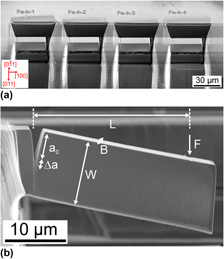Crossref Citations
This article has been cited by the following publications. This list is generated based on data provided by
Crossref.
Ast, Johannes
Göken, Mathias
and
Durst, Karsten
2017.
Size-dependent fracture toughness of tungsten.
Acta Materialia,
Vol. 138,
Issue. ,
p.
198.
Deng, Yun
Hajilou, Tarlan
and
Barnoush, Afrooz
2017.
Hydrogen-enhanced cracking revealed by
in situ
micro-cantilever bending test inside environmental scanning electron microscope
.
Philosophical Transactions of the Royal Society A: Mathematical, Physical and Engineering Sciences,
Vol. 375,
Issue. 2098,
p.
20170106.
Alfreider, Markus
Kozic, Darjan
Kolednik, Otmar
and
Kiener, Daniel
2018.
In-situ elastic-plastic fracture mechanics on the microscale by means of continuous dynamical testing.
Materials & Design,
Vol. 148,
Issue. ,
p.
177.
Yin, Denise
Marvel, Christopher J.
Cui, Fiona Yuwei
Vinci, Richard P.
and
Harmer, Martin P.
2018.
Microstructure and fracture toughness of electrodeposited Ni-21 at.% W alloy thick films.
Acta Materialia,
Vol. 143,
Issue. ,
p.
272.
Ast, J.
Schwiedrzik, J.J.
Wehrs, J.
Frey, D.
Polyakov, M.N.
Michler, J.
and
Maeder, X.
2018.
The brittle-ductile transition of tungsten single crystals at the micro-scale.
Materials & Design,
Vol. 152,
Issue. ,
p.
168.
Schwiedrzik, J.J.
Ast, J.
Pethö, L.
Maeder, X.
and
Michler, J.
2018.
A new push‐pull sample design for microscale mode 1 fracture toughness measurements under uniaxial tension.
Fatigue & Fracture of Engineering Materials & Structures,
Vol. 41,
Issue. 5,
p.
991.
Merle, B.
and
Höppel, H. W.
2018.
Microscale High-Cycle Fatigue Testing by Dynamic Micropillar Compression Using Continuous Stiffness Measurement.
Experimental Mechanics,
Vol. 58,
Issue. 3,
p.
465.
Pippan, R.
Wurster, S.
and
Kiener, D.
2018.
Fracture mechanics of micro samples: Fundamental considerations.
Materials & Design,
Vol. 159,
Issue. ,
p.
252.
Niu, Haiyang
Niu, Shiwei
and
Oganov, Artem R.
2019.
Simple and accurate model of fracture toughness of solids.
Journal of Applied Physics,
Vol. 125,
Issue. 6,
Kumar, A.
Saxena, A.K.
Kirchlechner, C.
Herbig, M.
Brinckmann, S.
Petrov, R.H.
and
Sietsma, J.
2019.
In situ study on fracture behaviour of white etching layers formed on rails.
Acta Materialia,
Vol. 180,
Issue. ,
p.
60.
Mazhnik, Efim
and
Oganov, Artem R.
2019.
A model of hardness and fracture toughness of solids.
Journal of Applied Physics,
Vol. 126,
Issue. 12,
Luksch, Jutta
Jung, Anne
Pauly, Christoph
Motz, Christian
Mücklich, Frank
and
Schaefer, Florian
2019.
Effect of Pretreatment on Interface Stability and Morphology of Ni/Al Hybrid Foams by in situ Microcantilever Fracture Experiment.
Procedia Structural Integrity,
Vol. 17,
Issue. ,
p.
206.
Saxena, Ashish Kumar
Kumar, Ankit
Herbig, Michael
Brinckmann, Steffen
Dehm, Gerhard
and
Kirchlechner, Christoph
2019.
Micro fracture investigations of white etching layers.
Materials & Design,
Vol. 180,
Issue. ,
p.
107892.
Ast, J.
Ghidelli, M.
Durst, K.
Göken, M.
Sebastiani, M.
and
Korsunsky, A.M.
2019.
A review of experimental approaches to fracture toughness evaluation at the micro-scale.
Materials & Design,
Vol. 173,
Issue. ,
p.
107762.
Cheng, Yangyang
Yu, Long
Chen, Lirong
Liu, Wenbin
Yi, Xin
and
Duan, Huiling
2019.
Failure of fracture toughness criterion at small scales.
Physical Review Materials,
Vol. 3,
Issue. 11,
Snartland, Brage Dahl
and
Thaulow, Christian
2020.
Fracture toughness testing at the micro-scale − The effect of the unloading compliance method.
Engineering Fracture Mechanics,
Vol. 235,
Issue. ,
p.
107135.
Saxena, Ashish Kumar
Brinckmann, Steffen
Völker, Bernhard
Dehm, Gerhard
and
Kirchlechner, Christoph
2020.
Experimental conditions affecting the measured fracture toughness at the microscale: Notch geometry and crack extension measurement.
Materials & Design,
Vol. 191,
Issue. ,
p.
108582.
Alfreider, Markus
Zechner, Johannes
and
Kiener, Daniel
2020.
Addressing Fracture Properties of Individual Constituents Within a Cu-WTi-SiOx-Si Multilayer.
JOM,
Vol. 72,
Issue. 12,
p.
4551.
Alfreider, Markus
Kolitsch, Stefan
Wurster, Stefan
and
Kiener, Daniel
2020.
An analytical solution for the correct determination of crack lengths via cantilever stiffness.
Materials & Design,
Vol. 194,
Issue. ,
p.
108914.
Burtscher, Michael
Alfreider, Markus
Schmuck, Klemens
Clemens, Helmut
Mayer, Svea
and
Kiener, Daniel
2021.
In situ fracture observations of distinct interface types within a fully lamellar intermetallic TiAl alloy.
Journal of Materials Research,
Vol. 36,
Issue. 12,
p.
2465.




